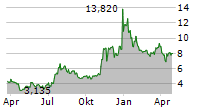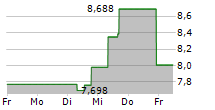New clinical Precision Medicine population data demonstrates up to 84.6 Weeks (19.5 Months) 'time saved' by early-start
ADAS-Cog13 difference: -5.43 (P = 0.0035), ADCS-ADL difference: +9.50 (P < 0.0001)
Restoring impaired autophagy as early event, preceding amyloid-beta and tau
Oral presentation at the Alzheimer's Association International Conference (AAIC) 2025
NEW YORK, July 31, 2025 (GLOBE NEWSWIRE) -- Anavex Life Sciences Corp. ("Anavex" or the "Company") (Nasdaq: AVXL), a clinical-stage biopharmaceutical company focused on developing innovative treatments for Alzheimer's disease, Parkinson's disease, schizophrenia, neurodevelopmental, neurodegenerative, and rare diseases, including Rett syndrome, and other central nervous system (CNS) disorders, announced today the latest findings for blarcamesine, an oral small molecule for the potential treatment of early Alzheimer's disease.
The data were presented by Marwan Noel Sabbagh, MD, Professor of Neurology, and Chairman of the Anavex Scientific Advisory Board at the 2025 Alzheimer's Association International Conference (AAIC), held in Toronto.
The ATTENTION-AD (ANAVEX®2-73-AD-EP-004) open-label extension (OLE) Phase IIb/III treatment trial followed the 48-week ANAVEX®2-73-AD-004 double-blind (DB) clinical trial, with a combined duration of up to 192 weeks. The trial was designed to evaluate the safety and tolerability of blarcamesine as well as its long-term effects on cognition (ADAS-Cog13) and function (ADCS-ADL) in participants with early Alzheimer's disease.1
Blarcamesine-treated patients continue to accrue benefit through up to 4 years, as measured by the prespecified clinical endpoints ADAS-Cog13 and ADCS-ADL, respectively. In the intent-to-treat (ITT) population, delayed-start analysis of treatment with oral blarcamesine was significant for both cognition and function, reflecting the importance of early treatment initiation. For ADAS-Cog13 a significant difference between the early-start and late-start treatment groups at Week 192 (LS mean difference -3.83, P = 0.0165) was observed.2 Similarly, for ADCS-ADL at Week 192 statistical significance (LS mean difference +4.30, P = 0.0206) was reached, both favoring the early-start group. Additionally, the GWAS-identified3 population ABCLEAR24, with a global frequency of ~71.7%5, showed further improvement in both cognition, ADAS-Cog13 (LS mean difference -5.43, P = 0.0035), and function, ADCS-ADL (LS mean difference +9.50, P < 0.0001), respectively. This clinical Precision Medicine population data demonstrates up to 84.6 Weeks (19.5 Months) of 'time saved' by the early-start analysis.
In Alzheimer's disease clinical trials, 'time saved' refers to the estimated amount of time a treatment delays the progression of the disease, allowing patients to maintain functionality and independence longer. This approach provides a clinically meaningful measure, as it directly relates to the impact on a patient's daily life.6,7 Additionally, blarcamesine exhibited a favorable safety profile with no treatment-related deaths.
"This Precision Medicine data provide potentially continued persuasive evidence that earlier initiation of treatment with blarcamesine may have a significant positive impact on disease progression and may provide sustained clinically meaningful benefits to patients with early Alzheimer's disease over the long-term," said Dr. Sabbagh. "Prespecified delayed-start analysis indicate disease-modifying effect of oral blarcamesine and highlight the importance of early and continued long-term treatment of chronic Alzheimer's disease. These enhanced clinically meaningful improvements are accompanied by blarcamesine's favorable safety profile. This could help reduce crucial barriers within the currently complex healthcare ecosystem for Alzheimer's disease and potentially provide broader access to a diverse population with early Alzheimer's disease."
Further presentations at the AAIC 2025 Conference featured prespecified Precision Medicine Phase IIb/III 48-week ANAVEX®2-73-AD-004 double-blind (DB) clinical trial data on blarcamesine, confirming the upstream mechanism of blarcamesine, restoring impaired autophagy as an early event, preceding amyloid-beta and tau.
The mechanistic confirmation that blarcamesine restores impaired autophagy through SIGMAR1 activation by acting upstream of amyloid and tau pathologies at the molecular level was previously established both in vitro and in vivo. Specifically, studies demonstrated enhanced autophagic flux in human cells and in C. elegans as well as increased proteostasis capacity, ultimately ameliorating paralysis caused by protein aggregation in C. elegans.8
A clinical Precision Medicine approach confirmed that the prespecified SIGMAR1 non-mutated population, termed ABCLEAR19, which represents up to ~70% of the global population, achieved deeper clinical responses to blarcamesine than the respective ITT population, hence also confirming clinical activation of SIGMAR1 through blarcamesine. Additional non-mutated populations with potentially enhanced responses could also be identified through Genome-Wide Association Study (GWAS) analyses. Data confirmed that within a heterogeneous Alzheimer's disease population by targeting a prevalent genetic profile through Precision Medicine approach, the efficacy of blarcamesine may be further improved.
While in the ITT population trial participants showed significant improvement versus placebo after 48 Weeks in the ANAVEX®2-73-AD-004 double-blind (DB) clinical trial by 36.3% for the key endpoints, ADAS-Cog13 and 27.6% for CDR-SB, respectively, a further, also significant, improvement was observed in the prespecified analysis of SIGMAR1 wild type (WT) carriers, ABCLEAR1 population.10 Compared to the ITT population, the ABCLEAR1 population demonstrated additional and consistent improvement versus placebo. ADAS-Cog13 and CDR-SB for the total blarcamesine group improved by 49.8% and 33.6%, respectively and for the 30 mg blarcamesine group by 49.1% and 35.5%, respectively. For the 30 mg blarcamesine group, serious treatment emergent adverse events (TEAEs) occurred in 10 participants (12.7%) receiving blarcamesine and in 6 participants (9.1%) receiving placebo. Common TEAEs included dizziness, which was transient and mostly mild to moderate in severity. There were no deaths in the blarcamesine 30 mg group, and one death occurred in the placebo group.
"We remain excited about these enhanced clinically meaningful improvements which were further confirmed by the observed efficacy treatment effects from the two blarcamesine clinical trials with identified Precision Medicine patient populations," said Juan Carlos Lopez-Talavera, MD, PhD, Head of Research and Development of Anavex. "Convenient once-daily oral dosing of blarcamesine may allow us to offer a scalable and patient friendly oral pill administration option to patients with early Alzheimer's."
"We are motivated by the Anavex team's continued contributions to advancing science across this devastating chronic disease at the Alzheimer's Association International Conference 2025. Alzheimer's disease, like other chronic progressive diseases, requires a long-term therapeutic strategy. Blarcamesine's Precision Medicine mechanism of action with its convenient once daily oral dosing may lead to greater clinical benefit," said Christopher U Missling, PhD, President and Chief Executive Officer of Anavex. "Additionally, the comprehensive data from the blarcamesine Alzheimer's disease program represents a solid foundation for continuous engagement with the Alzheimer's disease community."
The respective presentations are available on the Investors section of the Company's website at www.anavex.com.
This release discusses investigational uses of an agent in development and is not intended to convey conclusions about efficacy or safety. There is no guarantee that any investigational uses of such product will successfully complete clinical development or gain health authority approval.
About Anavex Life Sciences Corp.
Anavex Life Sciences Corp. (Nasdaq: AVXL) is a publicly traded biopharmaceutical company dedicated to the development of novel therapeutics for the treatment of neurodegenerative, neurodevelopmental, and neuropsychiatric disorders, including Alzheimer's disease, Parkinson's disease, schizophrenia, Rett syndrome, and other central nervous system (CNS) diseases, pain, and various types of cancer. Anavex's lead drug candidate, ANAVEX®2-73 (blarcamesine), has successfully completed a Phase 2a and a Phase 2b/3 clinical trial for Alzheimer's disease, a Phase 2 proof-of-concept study in Parkinson's disease dementia, and both a Phase 2 and a Phase 3 study in adult patients and one Phase 2/3 study in pediatric patients with Rett syndrome. ANAVEX®2-73 is an orally available drug candidate designed to restore cellular homeostasis by targeting SIGMAR1 and muscarinic receptors. Preclinical studies demonstrated its potential to halt and/or reverse the course of Alzheimer's disease. ANAVEX®2-73 also exhibited anticonvulsant, anti-amnesic, neuroprotective, and anti-depressant properties in animal models, indicating its potential to treat additional CNS disorders, including epilepsy. The Michael J. Fox Foundation for Parkinson's Research previously awarded Anavex a research grant, which fully funded a preclinical study to develop ANAVEX®2-73 for the treatment of Parkinson's disease. We believe that ANAVEX®3-71, which targets SIGMAR1 and M1 muscarinic receptors, is a promising clinical stage drug candidate demonstrating disease-modifying activity against the major hallmarks of Alzheimer's disease in transgenic (3xTg-AD) mice, including cognitive deficits, amyloid, and tau pathologies. In preclinical trials, ANAVEX®3-71 has shown beneficial effects on mitochondrial dysfunction and neuroinflammation. Further information is available at www.anavex.com. You can also connect with the Company on Twitter, Facebook, Instagram, and LinkedIn.
Forward-Looking Statements
Statements in this press release that are not strictly historical in nature are forward-looking statements. These statements are only predictions based on current information and expectations and involve a number of risks and uncertainties. Actual events or results may differ materially from those projected in any of such statements due to various factors, including the risks set forth in the Company's most recent Annual Report on Form 10-K filed with the SEC. Readers are cautioned not to place undue reliance on these forward-looking statements, which speak only as of the date hereof. All forward-looking statements are qualified in their entirety by this cautionary statement and Anavex Life Sciences Corp. undertakes no obligation to revise or update this press release to reflect events or circumstances after the date hereof.
For Further Information:
Anavex Life Sciences Corp.
Research & Business Development
Toll-free: 1-844-689-3939
Email: info@anavex.com
Investors:
Andrew J. Barwicki
Investor Relations
Tel: 516-662-9461
Email: andrew@barwicki.com
1 The scheduled visits were [OLE Week 0 = Combined Week 48], [OLE Week 48 = Combined Week 96], [OLE Week 96 = Combined Week 144] and [OLE Week 144 = Combined Week 192]; Combined = OLE (open-label-extension) + DB (double-blind) trials.
2 ADAS-Cog13 scores LS mean difference between the treatment groups being larger than 2 points are considered clinically meaningful improvements: Muir RT, Hill MD, Black SE, Smith EE. Minimal clinically important difference in Alzheimer's disease: Rapid review. Alzheimers Dement. 2024;20(5):3352-3363.
3 GWAS = Genome-Wide Association Study
4 ABCLEAR2 = Alzheimer's Blarcamesine Cognition Efficacy and Resilience gene variant non-carrier population
5 Source: https://www.ncbi.nlm.nih.gov/snp/
6 Petersen, R C et al. "Expectations and clinical meaningfulness of randomized controlled trials." Alzheimer's & dementia: the journal of the Alzheimer's Association vol. 19,6 (2023): 2730-2736.
7 Dickson, S P et al. ""Time Saved" Calculations to Improve Decision-Making in Progressive Disease Studies." The journal of prevention of Alzheimer's disease. vol. 11,3 (2024): 529-536.
8 Christ, M G et al. "Sigma-1 Receptor Activation Induces Autophagy and Increases Proteostasis Capacity In Vitro and In Vivo." Cells vol. 8,3 211. 2 Mar. 2019.
9 ABCLEAR1 = Alzheimer's Blarcamesine Cognition Efficacy and Resilience gene variant non-carrier population (SIGMAR1 wild type [WT])
10 Macfarlane, S et al. "Blarcamesine for the treatment of Early Alzheimer's Disease: Results from the ANAVEX2-73-AD-004 Phase IIB/III trial." The journal of prevention of Alzheimer's disease. vol. 12,1 (2025).



